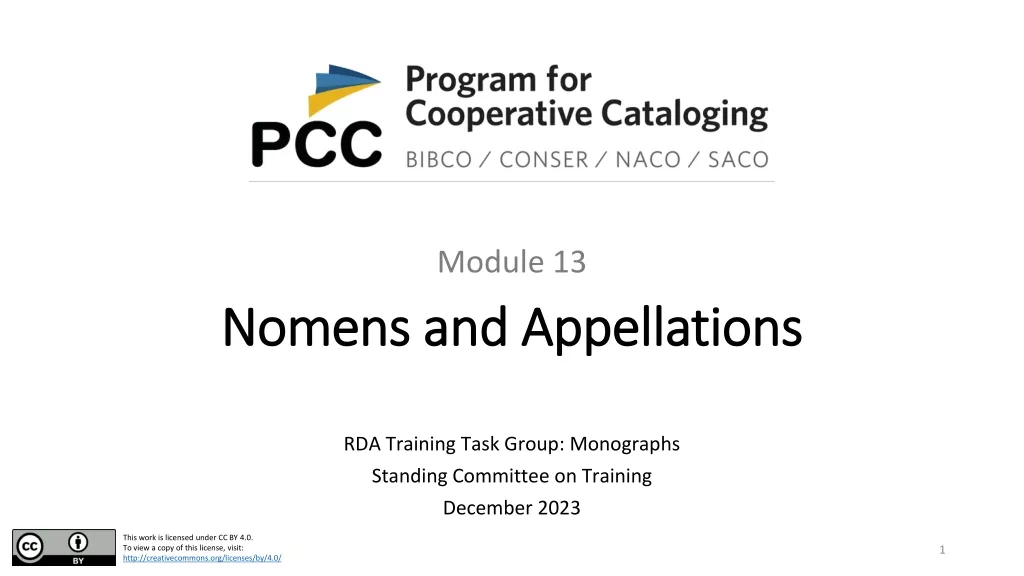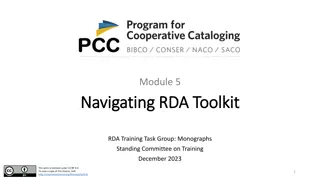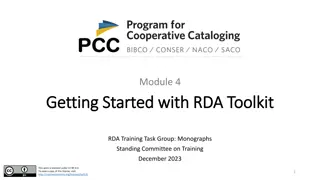Evolution of Cataloging Standards: From Cutter's Objects of the Catalog to RDA Development
The evolution of cataloging standards reflects a rich history dating back to the 19th century, from Cutter's Objects of the Catalog to the development of official RDA. Key milestones include the 3R Project, LRM, RDA Registry, and the shift in cataloging rules driven by changing user needs and digital resources. The Paris Principles in 1961 and the progression from AACR to AACR2 show the adaptability of cataloging principles over time.
Download Presentation

Please find below an Image/Link to download the presentation.
The content on the website is provided AS IS for your information and personal use only. It may not be sold, licensed, or shared on other websites without obtaining consent from the author.If you encounter any issues during the download, it is possible that the publisher has removed the file from their server.
You are allowed to download the files provided on this website for personal or commercial use, subject to the condition that they are used lawfully. All files are the property of their respective owners.
The content on the website is provided AS IS for your information and personal use only. It may not be sold, licensed, or shared on other websites without obtaining consent from the author.
E N D
Presentation Transcript
Module 2 Development and Basics of RDA Development and Basics of RDA RDA Training Task Group: Monographs Standing Committee on Training December 2023 This work is licensed under CC BY 4.0. To view a copy of this license, visit: http://creativecommons.org/licenses/by/4.0/ 1
Learning Outcomes At the end of this module, you will be able to: Summarize key developments in the history of RDA Differentiate official RDA from original RDA Identify basic and important terms about official RDA, including 3R Project, LRM (Library Reference Model), RDA Registry, etc. 2
Outline Before RDA FR (Functional Requirements) Models and IFLA s International Cataloging Principles The 3R Project LRM (Library Reference Model) RDA Toolkit RDA Registry RDA Implementation Scenarios 3
The Development of RDA Official RDA is the latest development in a long tradition of cataloging theory going back at least to the 19th century 4
Cutters 1876 Objects of the Catalog 1. To enable a person to find a book of which either (A) the author (B) the title or (C) the subject is known 2. To show what the library has (D) by a given author (E) on a given subject (F) in a given kind of literature [i.e., in a given genre] 3. To assist in the choice of the book (G) as to its edition (bibliographically) (H) as to its character (literary or topical) 5
Paris Principles (1961) The catalogue should be an efficient instrument for ascertaining whether the library contains a particular book specified by a. its author or title, or b. if the author is not named in the book, its title alone, or c. if the author and title are inappropriate or insufficient for identification, a suitable substitute for the title; and a. which works by a particular author and b. which editions of a particular work are in the library. 6
Anglo-American Cataloging Rules In 1967, two versions of the Anglo-American Cataloguing Rules (AACR) were published, a North American text and a British text. In 1978, the Anglo-American Cataloguing Rules, Second edition (AACR2) was published. AACR are principle-based rules rather than case-based, which makes them able to satisfy general users needs more effectively. However, the significant change of the environment in late 1990s, including the rise of the internet and the increasing use and exchange of e- resources brought new challenges. Investigation and reform of the cataloging rules was needed in the new era. 7
International Conference on the Principles and Future of AACR (1997) By the late 20th century, fundamental changes had taken place in the bibliographic environment Important conference held in Toronto International Conference on the Principles and Future of AACR, Toronto, Ontario, Canada, October 23-25, 1997 53 participants discussed nine papers These discussions influenced later developments, including (eventually) RDA 8
FR model (1998-2019) Functional Requirements for Bibliographic Records (FRBR) (1998) Functional Requirements for Authority Data (FRAD) (2009) Functional Requirements for Subject Authority Data (FRSAD) (2019) 9
FRBR A conceptual model of the bibliographic universe Based on the entity-relationship model developed for databases 10
Entity-Relationship Model Entity: Something that can be distinctly identified. Relationship: An association between two or more entities. Attribute: A characteristic that may identify instances of entities or relationships. 11
FRBR Entities Group 1: The products of intellectual or artistic endeavor. Sometimes called the primary entities. Work: a distinct intellectual or artistic creation Expression: the intellectual or artistic realization of a work in some form (e.g., alphanumeric, musical notation) Manifestation: the physical embodiment of an expression (e.g., a print publication) Item: a copy of a manifestation 12
FRBR/FRAD Entities Group 2: entities responsible for Group 1 entities Person: an individual or persona established or adopted by an individual or group Family: two or more persons related by birth, marriage, adoption, or similar legal status, or who otherwise present themselves as a family Corporate body: an organization or group of individuals and/or organizations acting as a unit 13
FRBR Entities Group 3: entities that can be subjects of works Any Group 1 or Group 2 entity, and Concept: an abstract notion or idea Object: a material thing Event: an action or occurrence Place: a location 14
Original RDA (2010) was based on FR entities and user tasks 15
Statement of International Cataloguing Principles 2016 2009 https://www.ifla.org/resources/?oPubId=406 https://www.ifla.org/resources/?oPubId=11015 16
Statement of International Cataloguing Principles General Principles Convenience of the user Cataloging decisions should be made with the user in mind Common usage Standardized vocabularies should reflect the vocabulary the majority of catalog users would expect Representation Descriptions and controlled forms of names should be based on the way entities describe themselves 17
Statement of International Cataloguing Principles General Principles Accuracy The description should be faithful to the entity described Sufficiency and necessity Only those elements that are essential to uniquely identify an entity should be included Significance Elements should be bibliographically significant 18
Statement of International Cataloguing Principles General Principles Economy Bibliographic control should be achieved by the simplest or least costly method Consistency and Standardization Descriptions and access points should be standardized as far as possible in the interest of consistency and sharing of records Integration Description of and access to all types of materials should be based on a common set of rules as much as possible 19
Statement of International Cataloguing Principles General Principles Interoperability Bibliographic and authority data should be shareable and reusable both within and outside the library community Openness Restrictions on data should be minimal in order to foster transparency and conform to Open Access principles Accessibility Data should conform to international standards for accessibility Rationality The rules in a cataloging code should be defensible and not arbitrary 20
Development of Original and Official RDA RDA is built on foundations established by the Anglo-American Cataloguing Rules. 2nd Edition (AACR2) and the cataloging traditions on which it was based. The IFLA Statement of International Cataloguing Principles (ICP) informs the cataloging principles used throughout RDA and guides the decisions that catalogers make. A key component in the design and development of RDA is its alignment with IFLA's bibliographic conceptual models. 21
Change of Conceptual Model for Official RDA The FR model, on which original RDA was based, was somewhat fragmented, having come out in three different publications which were slightly different from each other These were consolidated and were replaced with the IFLA Library Reference Model (LRM) 22
LRM: Library Reference Model IFLA Library Reference Model: A Conceptual Model for Bibliographic Information was published in 2017 Consolidates the FR family (FRBR, FRAD, FRSAD) into a single coherent high-level conceptual model A high-level conceptual reference model developed with an enhanced entity-relationship modeling framework 23
LRM: Library Reference Model Aims to make explicit general principles governing the logical structure of bibliographic information, without making presuppositions about how that data might be stored in any particular system or application Bases its functional scope on user tasks Find, Identify, Select, Obtain, Explore Is intended as a guide or basis on which to formulate cataloging rules and implement bibliographic systems 24
LRM: Entity Hierarchy Top Level Second Level Third Level E1 Res [from FRSAD s therma and generalized] E2 Work [FRBR] E3 Expression [FRBR] E4 Manifestation [FRBR] E5 Item [FRBR] E6 Agent E7 Person [FRBR] E8 Collective Agent [with 2 subclasses in RDA: family and corporate body ] E9 Nomen [FRAD/generalized] E10 Place [FRBR/redefined] E11 Time-span 25
LRM: Entity Relationship Model Composed of: Entities classify things of interest Relationships relationships that can exist between entities (36) Relationship Entity 1 (Person) Entity 2 (Work) Created Attributes further describe an entity or relationship in some way (37) Attribute Entity 1 (Expression) Certain value (English) Language 26
Function of IFLAs Models Introduce a systematic theoretical framework to understand the nature of the data Model s development focuses on users needs as the base of the data analysis Models are the starting point for developing applications; they are the basic road map in the process of developing cataloging standards Models are not intended to cover all the details; real-life applications may expand or omit parts Models promote data interoperability between communities with different traditions and practices 27
The 3R Project The 3R Project was announced in Oct. 2016 and began in 2017. It ended with the release of the official RDA Toolkit on Dec. 15, 2020 3R Project: RDA, Restructure, Redesign Changes covered in the project: Technology: updated the software, impacting the way RDA instructions are stored, updated, and accessed; the new content management system allows pieces to be reused wherever needed ( boilerplate language) and works better for developers, translators, and other content providers Content: aligned with IFLA s LRM 28
The 3R Project Why 3R Theoretical framework development: consolidate different conceptual models for a larger user group 2010: RDA aligned with FRBR and FRAD 2015: RDA aligned with FRBR, FRAD, and FRSAD 2017: LRM approved (FR models obsolete) Fitting better in digital environment as an online tool Optimized for the linked data environment A global standard for use in many contexts Remove Anglo-American perspective Not just for libraries 29
The 3R Project Official RDA vs. Original RDA Same/Similar: RDA purpose No fundamental change in practice for most catalogers who use original RDA Different: RDA scope broadened in response to international interest in the standard: more flexible, accommodating diverse practices Theoretical framework: LRM (IFLA Library Reference Model) vs. FRBR/FRAD/FRSAD User interface: content structure no linear presentation like an e-book Some guidelines/standards reorganized and expanded Instruction writing style 30
RDA Toolkit https://access.rdatoolkit.org/ RDA Toolkit is an integrated, browser-based, online product that allows users to interact with a collection of cataloging-related documents and resources, including RDA: Resource Description and Access. Includes the authoritative text of the standard in different languages Includes tools that support the integration of RDA into daily work The structure removes the conventions of a beginning, a middle, and an end Efficient linked data design, e.g., definitions in RDA are linked to the definition in the RDA Registry. A change of a definition in the RDA Registry will impact all the places in RDA where that definition appears. 31
RDA Registry https://www.rdaregistry.info/ RDA Registry is RDA s own defined namespace. RDA Registry contains vocabularies that represent the RDA entities, elements, and controlled terminologies as RDA element sets and RDA value vocabularies in Resource Description Framework (RDF). RDA translations usually start in the Registry. The RDA vocabularies are stable in that the canonical IRIs will not be changed, but classes and properties will still be amended. If a property is deleted from RDA itself, it will be deprecated in the RDA Registry but not deleted. RDA Registry provides a set of machine-actionable mappings, to and from RDA element sets and value vocabularies. The majority are from RDA to non-RDA. 32
RDA Implementation Scenarios RDA is not tied to a single encoding scheme or presentation style; it is optimized for the linked data environment, but data can also be recorded in ways that are compatible with simpler technological environments. RDA Toolkit: Guidance > RDA implementation scenarios lists FOUR scenarios illustrating the range of potential configurations of RDA data and reflecting the distinct structures that are commonly used for library and cultural heritage metadata. Data for any scenario can be re-used, with loss of detail, in a scenario later in the enumerated sequence. For example, Scenario A (Linked open data) can be collapsed into a Scenario D (Flat file data) implementation, and Scenario B (Relational or object-oriented data) can be coarsened into Scenario C (Bibliographic/authority data). 33
RDA Implementation Scenario A: Linked Open Data RDA data expressed in Resource Description Framework (RDF) using IRIs The IRI recording method is mainly used in this scenario for values taken from a vocabulary encoding scheme (VES), when available Example: Hamlet has creator person of work William Shakespeare http://viaf.org/viaf/176993890 http://rdaregistry.info/Elements/w/P10437 Example: RDF graph http://id.loc.gov/rwo/agents/n78095332 34
RDA Implementation Scenario B: Relational or Object-Oriented Data RDA entities and elements expressed in a set of structured data tables or columns Example: Hamlet has creator person of work William Shakespeare The identifier recording method is mainly used in this scenario for values taken from a vocabulary encoding scheme, when available Person Work Appellation n78095332 Appellation 176993890 Relationship (has creator person) n78095332 MARC languages Attribute (language of representative expression) eng Appellation eng Example: MS Access database Attribute English 35
RDA Implementation Scenario C: Bibliographic/Authority Data Data expressed in an encoding schema The structured description recording method is mainly used in this scenario for values taken from a vocabulary encoding scheme, when available Example: Hamlet has creator person of work William Shakespeare W+M+E(+I) Appellation Shakespeare, William, 1564- 1616. Hamlet Authority Record for Person Relationship (has creator person) Appellation Shakespeare, William, 1564- 1616. Shakespeare, William, 1564- 1616. Example: MARC 21 catalog 36
RDA Implementation Scenario D: Flat File Data Data expressed in a layout that uses a set of string encoding schemes The structured description recording method is mainly used in this scenario for values taken from a vocabulary encoding scheme, when available. The unstructured description recording method is used for values of other descriptive elements. Example: Hamlet has creator person of work William Shakespeare W+M+E(+I) Appellation Shakespeare, William, 1564- 1616. Hamlet Authority Card for Person Relationship (has creator person) Appellation Shakespeare, William, 1564- 1616. Shakespeare, William, 1564- 1616. Example: Card catalog 37
Summary Library resource description standards follow a long cataloging history going back to 19th century. FR models, which were the base of original RDA, are replaced by the IFLA Library Reference Model (LRM), with which official RDA aligns. The 3R Project was announced in Oct. 2016 and began in 2017. It ended with the release of the official RDA Toolkit on Dec. 15, 2020. Even though strongly leaning toward linked data, RDA offers different options for recording data regardless of the technological environment in which a metadata creator operates. 38























